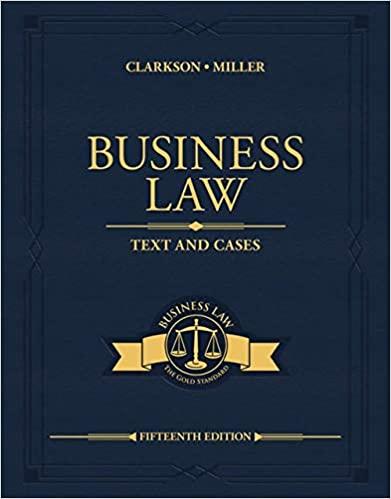Question
Please answer each question in this format! I. JUDGMENT II LEGAL PRINCIPLE A ISSUE (Question of Law) B HOLDING (Answer of Law) III REASONING A
Please answer each question in this format!
I. JUDGMENT
II LEGAL PRINCIPLE A ISSUE (Question of Law) B HOLDING (Answer of Law)
III REASONING A GENERAL ANALYSIS B APPLIED ANALYSIS
IV JUDGMENT
1. Al Rizek was a vice president of PaineWebber of Puerto Rico. One of his clients was Jorge Donato. Donato told Rizek that he was primarily interested in long-term bonds and the safety of his investment. In early 1993, Rizek recommended to Donato a strategy of short-term trading of zero-coupon bonds. Zero-coupon bonds are U.S. government instruments that accumulate interest until maturity, rather than paying interest periodically. The value of a zero-coupon bond is very sensitive to changes in interest rates. Rizek recommended that Donato purchase the bonds on margin, thus magnifying the potential gains and losses. Purchasing on margin meant that Donato had to make monthly margin interest payments to PaineWebber; it also placed him at risk of being forced to sell at a loss to meet a margin call. During the 15-month period from January 1993 to March 1994, Donato's account had average monthly balances of $85,000. During this time, Rizek carried out $2 million in transactions on the account. Rizek's strategy led to losses of approximately $12,000. Rizek received about $15,000 in commissions. Donato sued Rizek and Paine Webber to recover the damages he suffered. Have Rizek and PaineWebber violated the common law of negligence or Securities Exchange Act Rule 10b5?
2. Ernst & Young, an accounting firm, was retained by Camelot Systems Inc. to provide tax advice. Camelot also retained a law firm to provide tax and other legal advice. At all times, E&Y was working for and paid by Camelot. When the IRS investigated a merger transaction on which E&Y had worked for Camelot, it subpoenaed E&Y's records, including communications between E&Y and Camelot. Camelot sought to quash the subpoena on grounds that the communications between Camelot and E&Y were privileged and confidential. Did the court agree?
Step by Step Solution
There are 3 Steps involved in it
Step: 1

Get Instant Access to Expert-Tailored Solutions
See step-by-step solutions with expert insights and AI powered tools for academic success
Step: 2

Step: 3

Ace Your Homework with AI
Get the answers you need in no time with our AI-driven, step-by-step assistance
Get Started


